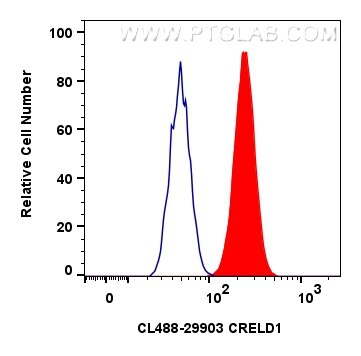CoraLite® Plus 488-conjugated CRELD1 Polyclonal antibody
CRELD1 Polyclonal Antibody for FC (Intra)
Host / Isotype
Rabbit / IgG
Reactivity
Human, mouse, rat
Applications
FC (Intra)
Conjugate
CoraLite® Plus 488 Fluorescent Dye
Cat no : CL488-29903
Synonyms
Validation Data Gallery
Tested Applications
| Positive FC detected in | HepG2 cells |
Recommended dilution
| Application | Dilution |
|---|---|
| Flow Cytometry (FC) | FC : 0.80 ug per 10^6 cells in a 100 µl suspension |
| It is recommended that this reagent should be titrated in each testing system to obtain optimal results. | |
| Sample-dependent, Check data in validation data gallery. | |
Product Information
CL488-29903 targets CRELD1 in FC (Intra) applications and shows reactivity with Human, mouse, rat samples.
| Tested Reactivity | Human, mouse, rat |
| Host / Isotype | Rabbit / IgG |
| Class | Polyclonal |
| Type | Antibody |
| Immunogen | CRELD1 fusion protein Ag31593 相同性解析による交差性が予測される生物種 |
| Full Name | cysteine-rich with EGF-like domains 1 |
| Calculated molecular weight | 45KD |
| Observed molecular weight | 45 kDa, 70-75 kDa |
| GenBank accession number | NM_001031717 |
| Gene symbol | CRELD1 |
| Gene ID (NCBI) | 78987 |
| Conjugate | CoraLite® Plus 488 Fluorescent Dye |
| Excitation/Emission maxima wavelengths | 493 nm / 522 nm |
| Form | Liquid |
| Purification Method | Antigen affinity purification |
| Storage Buffer | PBS with 50% Glycerol, 0.05% Proclin300, 0.5% BSA, pH 7.3. |
| Storage Conditions | Store at -20°C. Avoid exposure to light. Stable for one year after shipment. Aliquoting is unnecessary for -20oC storage. |
Background Information
CRELD1 (Cysteine-rich with EGF-like domain protein 1) belongs to matricellular proteins family. The encoded protein has a cysteine-rich with epidermal growth factor-like domain (PubMed: 12137942). Mutations in CRELD1 are the cause of atrioventricular septal defect (PubMed: 24697899). Alternate splicing results in multiple transcript variants. CRELD1 can be detected as 70-75 kDa in mouse lung (PMID: 24697899).
Protocols
| Product Specific Protocols | |
|---|---|
| FC protocol for CL Plus 488 CRELD1 antibody CL488-29903 | Download protocol |
| Standard Protocols | |
|---|---|
| Click here to view our Standard Protocols |


